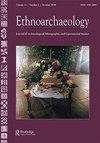如何保持家庭的火焰燃烧:陶瓷容器烹饪炉的比较研究
IF 1.3
0 ARCHAEOLOGY
引用次数: 5
摘要
灶台是故意生火的地方,通常以有机物质为燃料,如木材、木炭、作物废料或干燥的动物粪便(生物质或生物燃料)。壁炉也暗示着性别、区域生态和复杂的、象征性丰富的技术。这篇文章是关于家用灶台的,特别是与陶瓷灶台一起使用的生物质灶台。从国际发展项目、民族考古学、考古学和相关领域得出见解,以定义健康的类型。我们确定了壁炉结构与考古相关的其他关键属性之间的联系,包括烹饪容器形状、食物制备方法、燃料选择、劳动力分配、房屋建筑的方法和材料以及室内和室外空间的使用。此外,我们根据我们对当代印度拉贾斯坦邦发展的民族考古学研究来讨论这些联系。我们认为,扩大民族考古学的范围,考虑促进变化的国际发展努力,揭示了烹饪炉嵌入家庭的复杂方式。本文章由计算机程序翻译,如有差异,请以英文原文为准。
How to Keep the Home Fires Burning: A Comparative Study of Cooking Hearths for Ceramic Vessels
ABSTRACT A hearth is the location of an intentional fire, commonly fueled with organic matter such as wood, charcoal, crop waste, or dried animal dung (biomass, or biofuel). Hearths also implicate gender, regional ecologies, and complex, symbolically rich technologies. This article is about household cooking hearths—specifically, biomass hearths used with ceramic cooking vessels. Insights are drawn from international development projects, ethnoarchaeology, archaeology, and related fields to define types of hearths. We identify associations between hearth construction and other key attributes of archaeological relevance, including cooking vessel shape, food preparation methods, fuel choice, labor allocation, methods and materials of house construction, and use of indoor and outdoor spaces. Additionally, we discuss these associations based on our ethnoarchaeological study of development in contemporary Rajasthan, India. We argue that broadening the scope of ethnoarchaeology to consider international development efforts that promote change reveals the complicated ways that cooking hearths are embedded within households.
求助全文
通过发布文献求助,成功后即可免费获取论文全文。
去求助
来源期刊

Ethnoarchaeology
ARCHAEOLOGY-
CiteScore
1.60
自引率
0.00%
发文量
10
期刊介绍:
Ethnoarchaeology, a cross-cultural peer-reviewed journal, focuses on the present position, impact of, and future prospects of ethnoarchaeological and experimental studies approaches to anthropological research. The primary goal of this journal is to provide practitioners with an intellectual platform to showcase and appraise current research and theoretical and methodological directions for the 21st century. Although there has been an exponential increase in ethnoarchaeological and experimental research in the past thirty years, there is little that unifies or defines our subdiscipline. Ethnoarchaeology addresses this need, exploring what distinguishes ethnoarchaeological and experimental approaches, what methods connect practitioners, and what unique suite of research attributes we contribute to the better understanding of the human condition. In addition to research articles, the journal publishes book and other media reviews, periodic theme issues, and position statements by noted scholars.
 求助内容:
求助内容: 应助结果提醒方式:
应助结果提醒方式:


